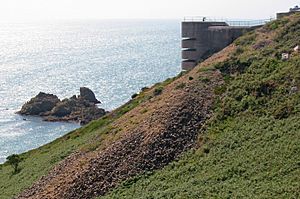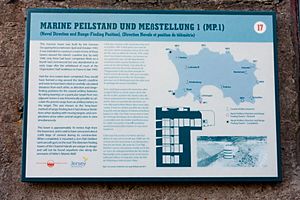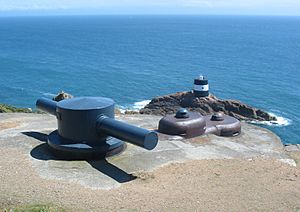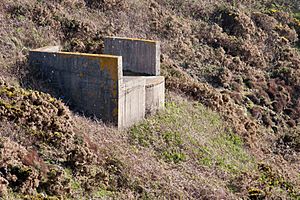Battery Lothringen facts for kids
Quick facts for kids Batterie Lothringen |
|
|---|---|
| Part of Atlantic Wall | |
| Noirmont Point, Saint Brélade, Jersey | |

Batterie Lothringen seen from the sea in 2009
|
|
 
Kriegsmarine Ensign
|
|
| Coordinates | 49°10′03″N 2°10′11″W / 49.1675°N 2.1696°W |
| Site information | |
| Owner | People of Jersey |
| Open to the public |
Yes |
| Condition | Some structures restored, others ruined |
| Site history | |
| Built | 1941 |
| Built by | Organisation Todt |
| In use | 1941–45 |
| Materials | Concrete, steel and timber |
| Events | German occupation of the Channel Islands |
| Garrison information | |
| Garrison | Kriegsmarine |
Battery Lothringen was a large World War II coastal gun battery located on Jersey, one of the Channel Islands. It was built by a group called Organisation Todt for the German military during their occupation of the islands. The battery was named after the German battleship SMS Lothringen.
Construction started in 1941. This was around the same time another nearby battery, Battery Moltke, was finished. Battery Lothringen sits at the very end of Noirmont Point, a rocky area that looks out over St. Aubin's Bay, Elizabeth Castle, and the busy harbours of Saint Helier.
This battery was an important part of the Atlantic Wall, a huge system of coastal defenses built by Germany along the coast of Europe. Many of its strong concrete structures are still standing today. The 3rd Battery of Naval Artillery Battalion 604 was stationed here, protecting the island's waters. The site also overlooks an older 19th-century tower called La Tour de Vinde.
Contents
Powerful Guns of Battery Lothringen
In 1941, Battery Lothringen had three powerful 15 cm SK L/45 naval guns. A fourth gun of the same type was added later. These guns were originally made by a company called Krupp and dated back to 1917.
The guns were placed on high concrete platforms. Ammunition was kept in special bunkers nearby. Soldiers had to move the ammunition by hand along concrete paths to smaller storage areas right next to the guns.
After the Channel Islands were freed in 1945, the British Army removed these big guns. They were later discarded at the bottom of the cliffs at Les Landes, in St Ouen.
Gun Position 1: A Recovered Cannon
Gun Position 1 had a gun placed on a concrete platform with walls and a ramp. There was also a small room next to the gun. Ammunition was stored in Bunker VII and carried up a sloping concrete path to be kept in small bays behind the gun.
Behind this platform, there used to be a barrack hut, an office, and a bunker for soldiers. Only the bunker remains today. In 1992, the cannon from Gun Position 1 was found and brought back to Noirmont Point. It was placed back on its platform in March 1998, with the help of a large Chinook helicopter!
Other Gun Positions
Gun Position 2 was on a concrete platform to the northeast of the main command bunker. Gun Position 3 also had a concrete platform. Since its ammunition bunkers were not very close, extra storage bays were built below the platform. Today, there is no gun at this spot, and part of the platform wall is missing from when the gun was removed. Gun Position 4 was also on a concrete platform.
Spotting Ships: The MP1 Tower
The Marine Peilstand 1 tower, or MP1 tower, was used to watch for ships at sea. This round tower is about 16 meters (52 feet) tall. It has four observation floors, each with wide and narrow openings for looking out. Each floor was used to observe for one of the four 15 cm naval guns.
The tower has five floors, plus an open rooftop. The main entrance is a steel door on the top floor, protected by a small opening for small arms. An Oerlikon 20 mm cannon was once on top of the tower to shoot down enemy aircraft. The gun is gone now, but its steel support can still be seen.
Built between April and October 1943, the tower is on a steep cliff. It was designed so it wouldn't stick out above the headland when seen from far away. This made it harder for enemies to spot. The tower was also covered in camouflage to hide it even more.
This is one of three such observation towers built in Jersey. Nine towers were planned, but only three were completed. These towers were meant to be placed around the entire coast of Jersey. This way, any two nearby towers could work together to find the exact location of a target using a method called triangulation. This information would then be sent to the artillery so the guns could aim and fire accurately.
Hidden Bunkers: Westwall Type 101v
Next to the MP1 tower is a personnel bunker called a Westwall type 101v. This bunker was sealed and filled in after the islands were freed. It was later dug out starting in 2009 by the Channel Islands Occupation Society.
The Command Center: Type M.132 Bunker
The command bunker is right next to the MP1 tower. It had a special armored naval rangefinder and two steel observation domes (cupolas). A periscope was used with the rangefinder to figure out the direction of targets.
This bunker was built between March 1943 and May 1944. It has two floors, one entrance, and an escape shaft. It is made of very strong reinforced concrete. The lower floor was a living area with nine rooms, including sleeping quarters for soldiers, rooms for officers, an office, a standby room, a heating plant, and a coal storage room. There's an escape shaft from the NCO's room.
The upper floor has the operations room, a washroom, toilets, a first aid room, and a telephone exchange. The main entrance is on this floor and is protected by two openings for defense. The operations room also provides access to the cupolas from below.
Today, only the arms of the rangefinder are original. They were found at the bottom of the cliffs, repaired, and put onto a new turret. This bunker has been restored and now operates as a museum during the tourist season.
Powerful Searchlights
Two large searchlights were placed on concrete platforms on either side of the headland. These searchlights would have lit up the sea at night to spot enemy ships. Today, only the platforms remain.
Visiting Battery Lothringen Today
The Noirmont Point site is open to the public all the time. There is a public car park at the end of the headland. Some of the old military buildings and their interiors have been restored. You can visit these at certain times, usually on Sundays.
The gun positions can be visited at any time. Two partly restored guns are on display at two of the gun platforms, giving visitors a glimpse into the past.
Remembering the Past: Memorials
In 1950, the States of Jersey bought the Noirmont headland. It became a memorial to all the people of Jersey who died during the German occupation. A special memorial stone was revealed at Noirmont on May 9, 1970, to mark 25 years since the island's liberation.
One of the bunkers has a plaque honoring two pilots from 263 Squadron of the British Royal Air Force. They died on December 7, 1942, when their Whirlwind fighter-bomber was shot down while attacking a German convoy near the Point.
There is also a memorial for 16 men from the US Navy's PT Boat Squadron 34. They died on August 9, 1944, during an attack on a German convoy moving guns from Guernsey to Jersey. Fourteen of these men were from PT 509, which crashed into a German minesweeper. The other two were from PT 503.
See also
- German occupation of the Channel Islands
- Coastal fortifications of Jersey







